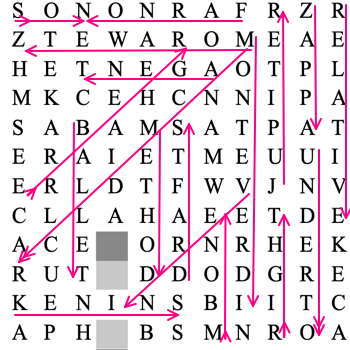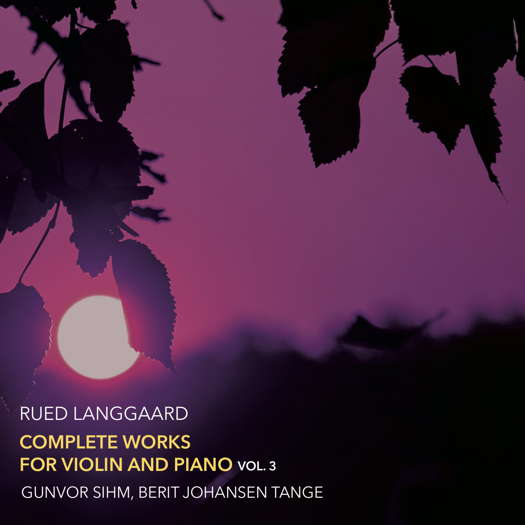- Jersey
- Valentin Silvestrov
- Huszka
- children
- Sicily
- Alfred Cortot
- Lawrence S Wittner
- James Barrington Stephens
 DISCUSSION: What is a work? John Dante Prevedini leads a discussion about The performing artist as co-creator, including contributions from Halida Dinova, Yekaterina Lebedeva, Béla Hartmann, David Arditti and Stephen Francis Vasta.
DISCUSSION: What is a work? John Dante Prevedini leads a discussion about The performing artist as co-creator, including contributions from Halida Dinova, Yekaterina Lebedeva, Béla Hartmann, David Arditti and Stephen Francis Vasta.
 WORD SEARCH: Can you solve Allan Rae's classical music word search puzzles? We're currently publishing one per month.
WORD SEARCH: Can you solve Allan Rae's classical music word search puzzles? We're currently publishing one per month.

Enigmatic yet Fascinating
Music by Rued Langgaard for violin and piano, heard by GERALD FENECH
'The conclusion of a visionary cycle that is worthy of serious attention.'
Rued Langgaard was born on 28 July 1893 in Copenhagen and died on 10 July 1952 in Ribe, just eighteen days before his fifty-ninth birthday. He was the only son of Siegfried and Emma Langgaard, both of whom were pianists. Aged five Rued began taking piano lessons with his mother, and later with his father and a private teacher. His talent emerged quickly, and at seven he was able to play the great piano works of Schumann and Chopin. At around this time Rued started to compose short pieces for the piano and organ, and at eleven he made his first public appearance as an organist and improvisor. One year later he started studying music theory and continued to experiment with composition. Indeed, when he was around thirteen he was taught counterpoint by the great Carl Nielsen, and had some of his pieces published. Not a bad start for a fledgling musician.
At nineteen he had his first symphony performed in Berlin, and in the early 1920s the composer experienced a brief interest of his symphonic works in Germany, where his most progressive pieces, Music of the Spheres (1916-18) and the Sixth Symphony (1919-20) were premiered. Sadly, in Denmark the music scene regarded the introvert and solitary soul-filled composer with near disdain. After such an auspicious start in his teens Langgaard never made the cut, and after he had had his opera Antichrist turned down by the Royal Danish Theatre, he reacted strongly by turning his back on modernism, and fiercely criticized the Danish musical scene. Langgaard's religiosity and symbolically tinged conception of music did not go hand in hand with the anti-Romantic, down-to-earth attitude that pervaded Danish music in the 1930s. Musical life followed the norms and the aesthetical track laid down by Carl Nielsen, and there was no room for an eccentric Romantic like Langgaard.
After a struggle lasting many years to gain a position as an organist within the Danish Church, in 1949 he was appointed cathedral organist in Ribe. Following his death in 1952, it seemed that Langgaard would remain just a name in Danish musical history. A performance of Music of the Spheres in 1968, however, gave rise to a serious evaluation of the musical legacy Langgaard left behind. Today, now that the main works are known, he is considered to be one of the most important Danish composers of the twentieth century. Langgaard's music is characterized by great stylistic variation, and often one comes across some very complex works that are unconventional in form and borne by a striving towards expressive image-creating and visionary modes of expression.
In his music there are elements that point forward to the 1960s and the avant-garde, minimalism and post-modernism of subsequent decades. Langgaard's works for violin and piano span a period of forty-three years (1907-1950), and they are like fixed points in his production, since all four main phases of his musical development are represented within this genre. This third and last volume in this mini-series includes the second and third violin sonatas and two very short pieces.
The first on this programme is Aubade, a small piece composed in August 1907 at the fishing hamlet of Arild on the Kullen Peninsula in the south of Sweden, when the then fourteen-year-old Rued was on a summer holiday with his parents. He dedicated the piece to his uncle, violinist Axel Gade, the son of the famous Nils Gade. This somewhat salon-inspired piece printed in 1907 is in F sharp major and in a simple three-section form.
Listen — Rued Langgaard: Aubade
(track 1, 0:01-0:58) ℗ 2021 Dacapo Records :
The Violin Sonata No 2 belongs to a group of works which Langgaard created around 1920, and which includes some of his most important compositions. Among these we find the Sixth Symphony and the opera Antichrist. This sonata strongly reflects Langgaard's philosophical thinking at the time; indeed, the music is inseparably linked to apocalyptic ideas and, in the wake of World War I, thoughts of a future religious idealistic society swirled in the composer's head. The catalyst of all this was to be a new kind of spiritual music that was to be at the forefront of this new 'quasi' utopic existence. The energy form and meaning of the music are rooted in clashes and interactions between musical statements of various natures and styles. This sonata is a prime example of contrasting elements, constructive and destructive, clashing and vying for supremacy. Published in 1922, it bore the motto 'The Great Master Comes' based on a well-known hymn by B S Ingemann. Premiered in January 1922 in Copenhagen, the work was coolly received and quickly fell by the wayside. The five-movement sonata had only four performances during the composer's lifetime, not much to write home about, but it was enough to place it among the most frequently performed Langgaard works in those days.
Listen — Rued Langgaard: original ending (Violin Sonata No 2)
(track 6, 6:43-7:42) ℗ 2021 Dacapo Records :
In 1948 the composer noted down an alternative ending which corresponds to the ending he had originally planned in 1920 but did not avail himself of. This ending has been recorded as an added bonus, and can be heard on Track 7.
Listen — Rued Langgaard: alternate ending (Violin Sonata No 2)
(track 7, 6:10-7:08) ℗ 2021 Dacapo Records :
Night Watchman's Song is one of the composer's earliest songs and was written in 1906 for a deep voice, violin or cello and piano. It was published that same year and the dedicatee was a friend of the family, the engineer and titular Counsellor of State William Fridericia. The lyrics comprise two traditional Danish night watchman's verses (those for 10pm and 11pm), the actual formulation of which is ascribed to hymn writer Thomas Kingo (1634-1703). Normally traditional melodies are used but Langgaard chose to write his own.
The Violin Sonata No 3 belongs to Langgaard's most retrospective compositions, and seems to have been written mainly for use in his private duo collaboration with the violinist Haakon Raskmark in Ribe. It is a kind of accumulative work which, during four years, grew from one to five movements. It commenced in 1945 with the first movement (but without the cadenza middle section) which was followed in 1946 by the present fifth movement, after which came the scherzo - the present third movement - in 1948. Later that year the first movement was enlarged by a violin cadenza as an introduction and a repetition of this as a middle section in the movement. Finally, in 1948 the present fourth movement was composed and in 1949 the first movement was divided so that the violin introduction was excised and enlarged into an independent concluding section, giving rise to the present second movement. A twisted journey indeed, but at least what we have today is the final five movement work.
Listen — Rued Langgaard: Finale. Allegro molto (Violin Sonata No 3)
(track 13, 3:23-4:22) ℗ 2021 Dacapo Records :
Despite the established romantic idiom of the classical sonata, this work is not conventional, rather it is what one could call intuitive. There is no thematic work or any development in any of the movements except for modulations. In the first movement there is neither a main theme nor a secondary one as in the classical norm, while the second movement begins most unusually with a repetition of the first movement cadenza. In a concluding section, the music is of a strange complex nature and without any logical connection with the first section of the movement. In this Violin Sonata No 3, Langgaard's intention seems to be a one-sided focusing on the music's charisma and its overt insistent optimism. Indeed, all five movements are in the major key.
Gunvor Sihm and Berit Johansen Tange are passionate advocates of this enigmatic yet fascinating composer. The levels of concentration are difficult to equal, and the vigour of accentuation is nuanced by an extreme flexibility of adaptation to constantly changing expressive utterances that permeate these rare scores. Not for sugary ears, but for those whose musical taste buds are more refined, this music is crying out to be heard. The conclusion of a visionary cycle that is worthy of serious attention. Sound and notes are top notch.
Copyright © 21 February 2021
Gerald Fenech,
Gzira, Malta

CD INFO - LANGGAARD: COMPLETE WORKS FOR VIOLIN AND PIANO 3
MORE CLASSICAL MUSIC ARTICLES ABOUT DENMARK


